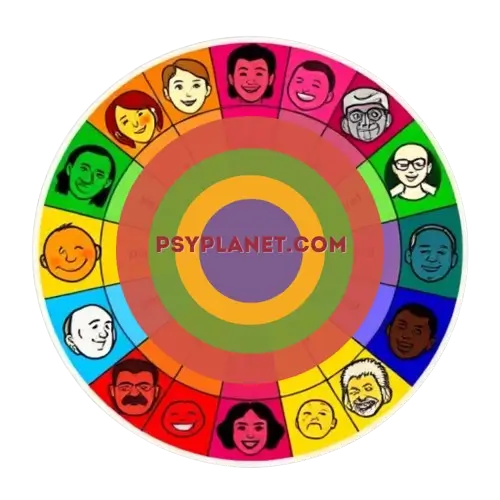Emotions

Why do you feel joy when watching a sunset or fear when walking down a dark street? Emotions govern our lives, and understanding them is key to achieving inner harmony. Emotions are complex psychophysiological states that arise in response to external or internal stimuli and play a crucial role in our behavior and decision-making.
What Are Emotions?
We typically define emotions as our body’s reactions to various events, situations, or thoughts. These reactions manifest as mental and physical changes, such as increased heart rate, sweating, or facial expressions. Affections range from simple feelings of happiness or sadness to more complex states like pride or guilt.
Emotions are not just what we feel but also how we express those feelings. Their influence on our lives is profound: they help us make decisions, interact with others, and even ensure our survival. For instance, fear can prompt us to avoid danger, while joy can motivate us to seek out positive experiences.
Emotional Maps and Models: Frameworks for Understanding Feelings
To better comprehend the vast landscape of human emotions, psychologists and researchers have developed several models and maps that categorize and explain different emotional experiences. These frameworks offer valuable insights into how affections are interrelated and how they influence our behavior.
1. Plutchik’s Wheel of Emotions

One of the most widely recognized models is Plutchik’s Wheel of Emotions, developed by psychologist Robert Plutchik. This wheel presents eight primary emotions: joy, trust, fear, surprise, sadness, disgust, anger, and anticipation. These affections are organized in a color-coded wheel to show how they can combine to form more complex emotional states. For instance:
- Joy + Trust = Love
- Fear + Surprise = Awe
- Sadness + Disgust = Remorse
Plutchik’s model also illustrates the intensity of emotions, with the strongest affections at the center of the wheel and milder forms radiating outward. This visual representation helps in understanding how emotions interact and evolve in response to different stimuli.
2. Ekman’s Basic Emotions
Another influential model is Paul Ekman’s Basic Emotions Theory. Ekman, a psychologist known for his work on facial expressions and emotion, identified six basic affections that are universally recognized across cultures: happiness, sadness, fear, disgust, anger, and surprise. Later, he expanded this list to include emotions like contempt, embarrassment, and excitement.
Ekman’s research is particularly significant because it highlights the biological basis of affections and their expression, emphasizing that certain emotional responses are innate and universal. This model is often used in studies of emotional recognition and nonverbal communication.
3. The Circumplex Model of Affect
Developed by James Russell, the Circumplex Model of Affect arranges emotions in a circular format based on two dimensions: arousal (high to low) and valence (positive to negative). This model categorizes emotions along these dimensions, showing how they relate to one another. For example:
- High Arousal + Positive Valence = Excitement
- Low Arousal + Negative Valence = Depression
The circumplex model is useful in understanding the spectrum of affections experiences and how we can shift from one emotional state to another. It’s particularly valuable in research on mood disorders and emotional regulation.
4. The Geneva Emotion Wheel
The Geneva Emotion Wheel is another tool that categorizes emotions along dimensions of control and intensity. This model was designed to help individuals recognize and label their emotional experiences more accurately. By providing a structured approach to identifying affections, the Geneva Emotion Wheel can be especially useful in therapeutic settings and self-reflection practices.
5. The Emotion Classification Model by Robert Thayer
Robert Thayer’s model, often referred to as the Mood Map, organizes emotions based on two dimensions: energy (high to low) and stress (calm to tense). This model categorizes affections into four quadrants:
- Calm-Energy (e.g., contentment, relaxation)
- Calm-Tiredness (e.g., tranquility, fatigue)
- Tense-Energy (e.g., anxiety, frustration)
- Tense-Tiredness (e.g., depression, exhaustion)
Thayer’s model helps in understanding how our energy levels and stress influence our emotional states, offering insights into how we can manage our affections through lifestyle changes like exercise, diet, and sleep.
Why These Models Matter
These emotional maps and models offer more than just a way to categorize feelings; they provide a deeper understanding of how emotions work and interact. Whether you’re looking to manage your own emotional responses or understand others’ affections better, these frameworks can be invaluable tools. They serve as a guide to navigating the complex world of emotions, helping you achieve greater emotional intelligence and well-being.
Cultural Differences in Perception of Emotions
Emotions are perceived and expressed differently across cultures. In Western cultures, expressing joy and pride is often seen as the norm, whereas in some Eastern cultures, such affections might be perceived as self-centered. Conversely, expressing sadness or grief may be more acceptable in one culture than in another.
Understanding these differences is important because they affect how we interact with others. When we recognize how our culture shapes our perception of emotions, we can better communicate with people from different backgrounds and avoid misunderstandings.
How Are Emotions Linked to Physiology?
Emotions are not just psychological phenomena but also physiological processes. When we experience strong affections like fear or anger, our endocrine system kicks into high gear, releasing hormones like adrenaline and cortisol. These hormones prepare our bodies for quick reactions: our heart rate increases, blood pressure rises, and muscles tense up.
These physiological changes help us cope with situations that require immediate action. For example, fear might drive us to flee from danger, while anger could prompt us to defend ourselves or our loved ones. Understanding this link between affection and physiology allows us to better manage our state and understand our body’s reactions to various stressors.
Regulating Emotions: How to Manage Emotional Reactions
We’ve all had moments where emotions overwhelm reason. However, there are many strategies for managing emotions that can help maintain inner balance. One such method is mindfulness, which involves being aware of your thoughts and feelings in the present moment without judgment.
Another key aspect of emotional regulation is cognitive reappraisal. This process involves changing your thoughts about an event to alter your emotional response. For instance, if someone criticizes you, rather than immediately feeling anger or hurt, you could consider that the criticism might be constructive and help you improve.
How Emotions Shape Your Life
Emotions play a central role in our lives, influencing our behavior, decisions, and relationships with others. They can become our allies if we learn to understand and manage them. We encourage you to observe your emotions over the next week, recognizing how they influence your actions and well-being. Use the knowledge from this article to better understand yourself and others, and manage your affections in a way that works for you, not against you.



